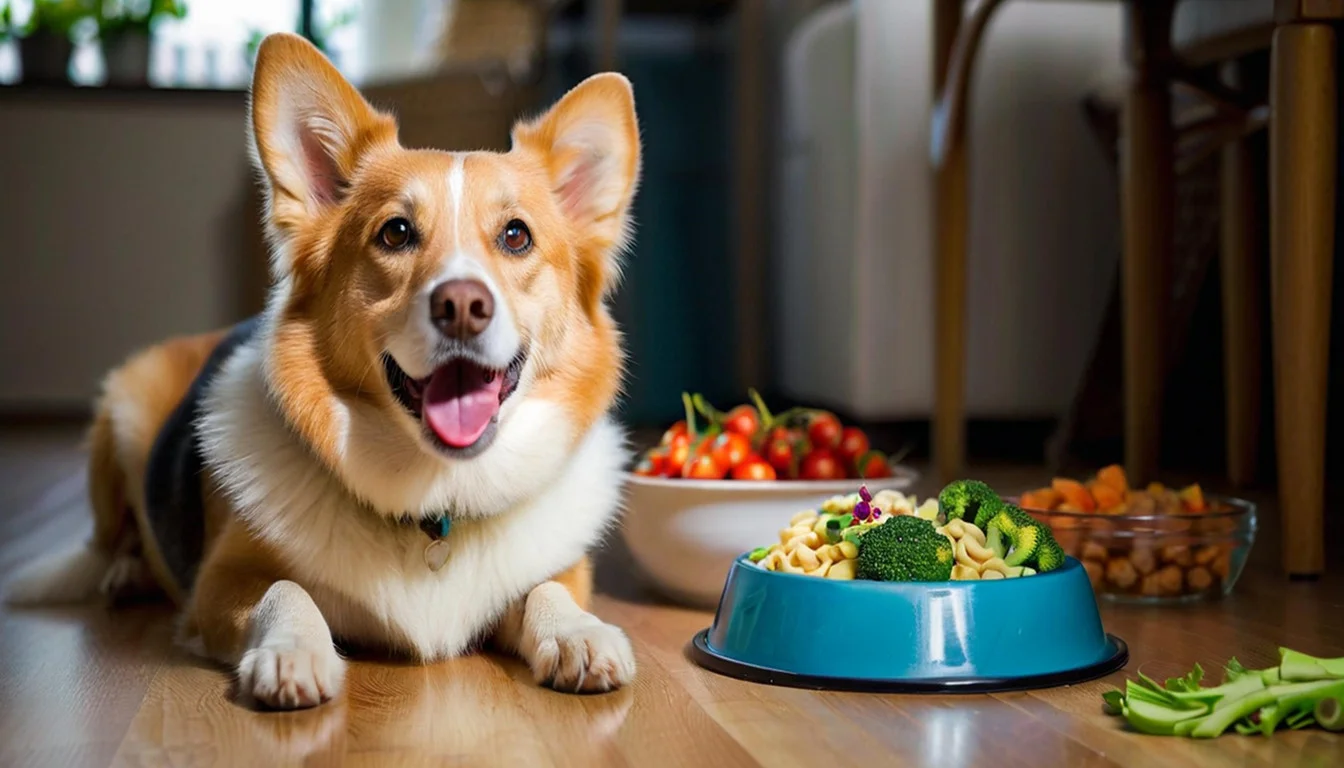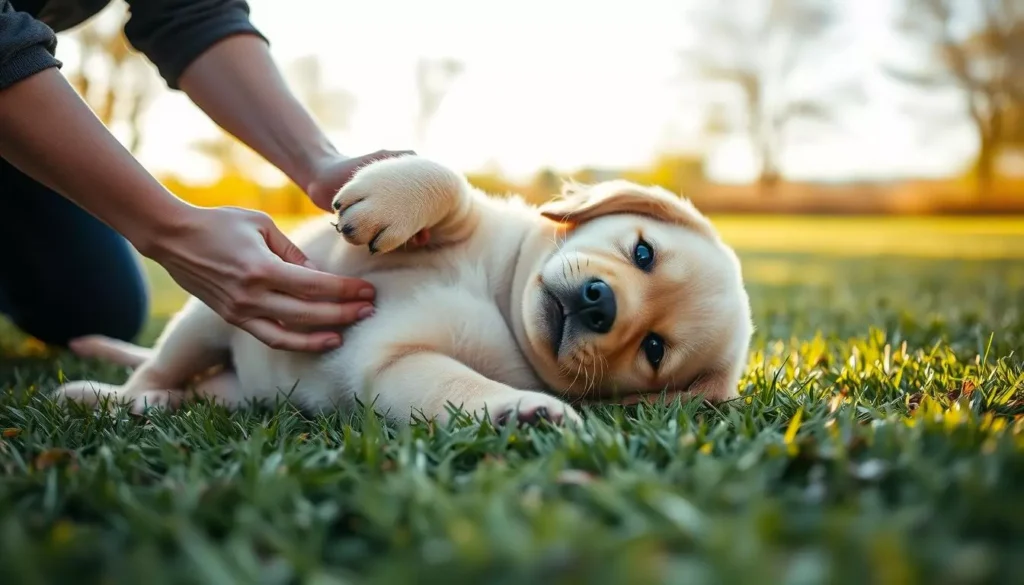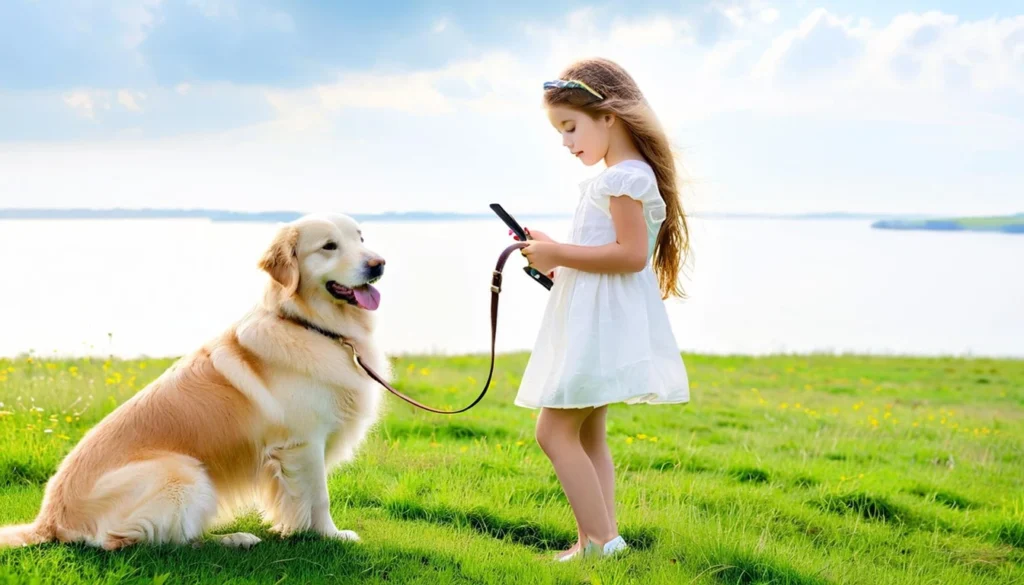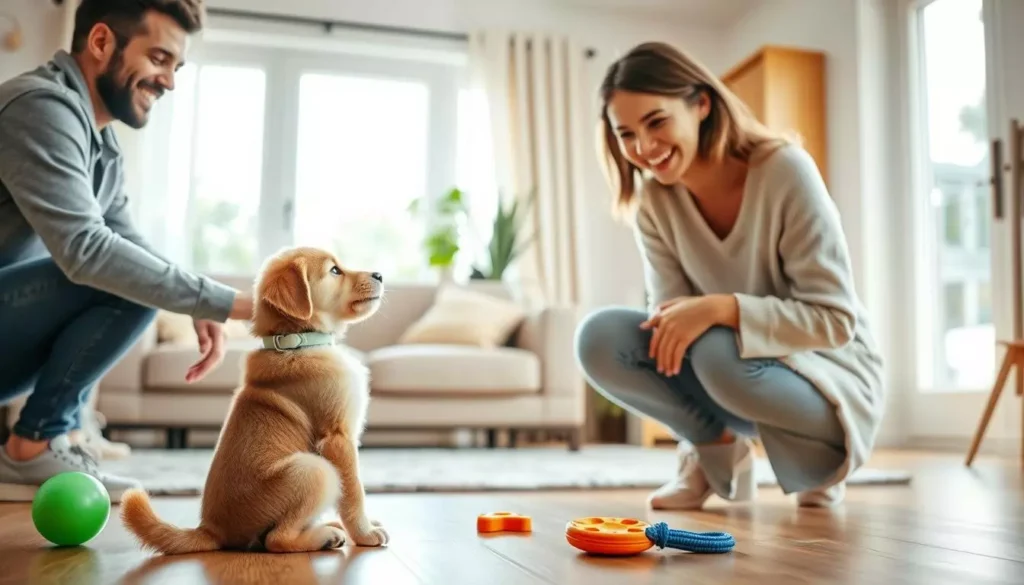I remember the first time my Labrador got tense over a chew. I thought food was just a simple joy for him. But that moment changed how I saw dog behavior around food. It showed me how quickly a peaceful meal can become dangerous.
Food aggression happens when a dog acts defensive or aggressive while eating or guarding items. It's also known as food bowl aggression. Dogs might growl, stare, or use their paws to warn others to stay away. If these warnings are ignored, they might even bite.
I learned to stay calm and not scold a dog when they get aggressive. It's important to keep everyone safe. Using strategies like feeding on a schedule and in quiet areas helps prevent accidents.
Before starting any training, it's crucial to check with a vet. They can rule out health issues like pain or hunger. If aggression is a problem, getting help from a behavior expert is key. This way, we can keep families safe and help dogs feel secure.
Key Takeaways
- Food aggression in dogs is often resource guarding and can range from growling to biting.
- Recognize graded signals—staring, freezing, chin on item—before escalation occurs.
- Do not confront or punish; withdraw calmly and implement safety management.
- Short-term steps like separate feeding areas and schedules reduce immediate risk.
- Always rule out medical causes with a veterinarian and consult a certified behavior professional if needed.
Understanding food-related aggression and resource guarding
I study behavior in pets and aim to help you understand why dogs guard items. Food-related aggression occurs when a dog defends its food from a perceived threat. This is different from other forms of aggression, like fear or territorial displays.
I want to share important information to help you stay calm. Resource guarding in dogs is about keeping valued items. This can range from harmless, like running off with a toy, to risky, like snapping when someone approaches a bowl.
I explain the roots of guarding behavior. In the wild, holding onto food, mates, and den sites helped survival. Pack dynamics and sibling competition teach puppies who eats first. These early lessons can lead to food guarding in dogs later on.
I also talk about the emotional side. Guarding can show confidence and control in some dogs. For others, it comes from fear and insecurity. Taking food away or having inconsistent responses can make guarding worse.
I list common triggers beyond meals. Chew bones, high-value toys, stolen items like socks, and favorite resting spots can spark guarding. Some dogs even guard people or locations they value.
I suggest practical choices for owners. Many manage mild guarding with barriers and steady feeding routines. If guarding is a risk, I urge seeking help from a certified behavior specialist.
types of food aggression in dogs
I help owners spot dog food aggression signs early by breaking it into levels. Food aggression is a type of aggression based on resources, not fear or territory. I explain the different levels so you know what to look for and how to react.

Mild signs
Growling, snarling, and baring teeth are early warnings. Your dog might eat faster, gulp, or pause. These signs mean they're uncomfortable and should not be ignored.
Moderate signs
Lunging and air snaps show a growing problem. Snapping close to people or pets, exaggerated gulping, and guarding the bowl are signs of higher risk. At this point, I add management tools and plan training.
Severe signs
Biting that breaks skin, chasing others, and repeated bites are severe. These signs need immediate safety and a visit to a specialist like a Dip ACVB or CAAB.
How severity guides action
Mild cases might need prevention and training. Moderate cases require controlled training with barriers or separate feeding. Severe cases need strict management and professional help right away.
I find that there are two main types of aggression in dogs: resource-based and non-resource-based. Food aggression is a resource-based problem, common in many dog behavior issues. Tracking the signs and their frequency helps me choose the right approach.
Recognizing dog food aggression signs early
I watch dogs while they eat to catch small changes before they become big problems. Spotting subtle cues helps with recognizing food guarding in dogs and with understanding dog aggression over food. Early awareness is central to preventing food aggression in dogs and keeping families safe.
I pay attention to posture and motion. A dog that stiffens, freezes, or adopts a low, hovering stance over the bowl is sending a clear message. A fixed stare, visible eye whites, ears pinned back, or raised hackles are other subtle body language signals to note.
I watch for shifts in eating style. Speeding up, gulping, stopping mid-meal, or suddenly refusing food when someone approaches are behavioral cues that predict escalation. Repeated low-level warnings such as quiet growls or snarls can build into lunging or snapping if left unchecked.
I keep a simple incident log to reveal patterns. Record the date, time, type of food, who was nearby, exact behaviors, and what happened next. Short notes make it easier to share clear examples with a trainer or veterinarian when needed.
Video can be very helpful when it is safe to record. A short clip often shows micro-signals I miss in the moment. Use footage to support a behavior plan that states measurable goals like fewer warnings and calmer eating across a set number of sessions.
My rule is never to provoke guarding for a test. I use management to prevent risky moments while I gather natural observations. That way I work on recognizing food guarding in dogs without escalating the problem or placing anyone in danger.
| What to Watch | Example Behavior | Why it Matters |
|---|---|---|
| Stiffening or freezing | Body locks over the bowl, little movement | May be the first sign before a warning growl |
| Fixed stare / eye whites | Intense gaze while eating or when approached | Predicts higher arousal and possible escalation |
| Speeded eating or gulping | Inhaling food, swallowing quickly | Shows anxiety about resource safety |
| Low-level warnings | Growls, snarls, brief lip lift | Early behavioral cues that predict escalation |
| Refusal or guarding elsewhere | Leaves bowl to guard a toy or chewed item | Indicates guarding is not limited to the bowl |
| Recording practices | Log date, time, context, behaviors, outcome | Creates a factual basis for a behavior plan |
Common causes and risk factors for aggressive behavior around food
I explore why some dogs guard their food and what increases this risk. Knowing the causes of food aggression in dogs helps me create safer routines. This way, I can prevent aggression before it starts.
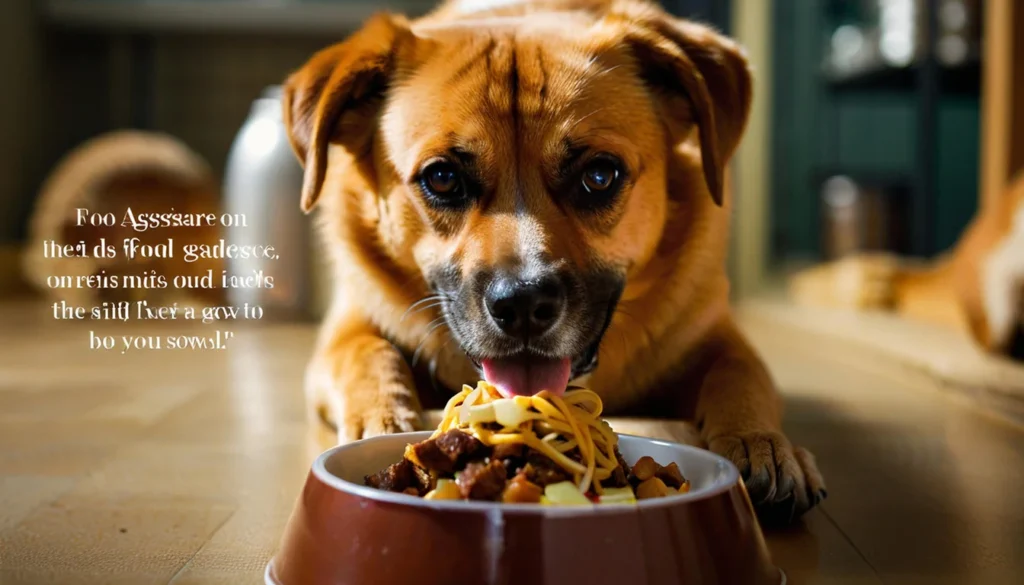
Genetics and early experiences shape a dog's temperament. Some breeds are naturally more protective of their food. Puppies that fight over food or win contests may learn to be possessive.
A history of using growling or snapping to keep others away is a big risk factor. This learned behavior can lead to food guarding.
Medical issues can quickly change a dog's behavior. Hunger from underfeeding or metabolic problems can increase aggression. Pain, especially around the mouth, can make a dog more protective of their food.
It's important to rule out illness when a dog starts showing aggressive behavior around food. A vet check can help determine if there's a medical reason behind the behavior.
The environment and routine also play a big role. Free-feeding or irregular schedules can make a dog anxious about when they'll eat next. High-value items, like human food, can also trigger guarding.
Busy feeding spots, children, or sudden changes in the household can make a dog more protective of their food. These changes can trigger guarding in dogs that never showed it before.
Practical steps can help reduce these triggers while training continues. I recommend consistent meal times and calm, separate feeding spots. Avoiding new, high-value treats until training starts is also important.
These steps are key to managing food aggression in dogs. They help lower the immediate risk of aggression.
| Factor | How it raises guarding risk | Simple management steps |
|---|---|---|
| Genetics & breed tendencies | Inherited guarding drive or high resource value placed on food | Use predictable routines and start early socialization; seek breed-aware trainers |
| Early litter experiences | Competition at feeding teaches monopolizing behavior | Provide supervised, separate feeding for puppies; discourage resource fights |
| Reinforcement history | Aggression that works becomes stronger | Prevent success from guarding with management and reward calm behavior |
| Hunger & metabolic issues | Increased motivation raises reactivity around food | Consult your veterinarian, adjust diet and feeding frequency |
| Pain or illness | Low tolerance for touch near mouth increases aggression risk | Vet exam, pain management, gentle handling during recovery |
| Feeding routine & location | Irregular schedules and high-traffic spots create anxiety | Establish quiet, consistent feeding times and separate areas |
| Novel or high-value foods | Perceived extra value triggers stronger guarding | Introduce new foods slowly while practicing trust-building exercises |
Assessing whether management alone is enough or you need help
I look at each case carefully, keeping safety and practicality in mind. Some dogs show mild guarding that only happens in one situation. They respond well to simple changes. I tell you when basic steps can keep everyone safe and when you should get help from a specialist.
When simple management can keep everyone safe
If a dog guards only one bowl or chew, simple management might work. I check for no history of lunging or biting and steady improvement with clear rules.
Households that use crates, gates, or separate feeding areas and follow safety rules for children and guests are often safe. I teach owners how to use treat-tossing and monitoring to help prevent food aggression in dogs.
Red flags indicating you should consult a behavior professional
I suggest getting help if there's any lunging that breaks skin, attempted bites, chasing, or clear escalation. Guarding that spreads to resting places, toys, or people is also a concern.
If children, elderly people, or visitors are at risk, seek help immediately. If you're unsure about reading body language or can't apply safe steps, it's time to ask a professional.
Types of certified professionals to seek
I recommend finding the right credential for your case. A Certified Applied Animal Behaviorist (CAAB) or ACAAB offers deep behavior science and handles complex aggression. A board-certified veterinary behaviorist (Dip ACVB) is a veterinarian who can assess medical causes and prescribe medication when needed.
A Certified Professional Dog Trainer (CPDT) with documented experience in aggression can guide behavior modification when the case is suitable for training. Look for CAAB Dip ACVB CPDT listings in trusted directories when deciding who to contact.
| Situation | Who to consult | What they offer |
|---|---|---|
| Mild, single-context guarding | Experienced CPDT | Behavior modification plans, owner coaching, safety protocols |
| Escalation or attempted bites | CAAB | Comprehensive behavior assessment, long-term behavior strategies |
| Suspected medical link or severe aggression | Dip ACVB | Medical evaluation, medication management, integrated plans |
| Households needing prevention guidance | CPDT or CAAB | Training for preventing food aggression in dogs and safe management |
Short-term management strategies to prevent accidents
I want to keep people and pets safe while we work on behavior. Short-term management of food aggression is about clear boundaries, simple tools, and predictable routines. These steps reduce risk and buy time for training.
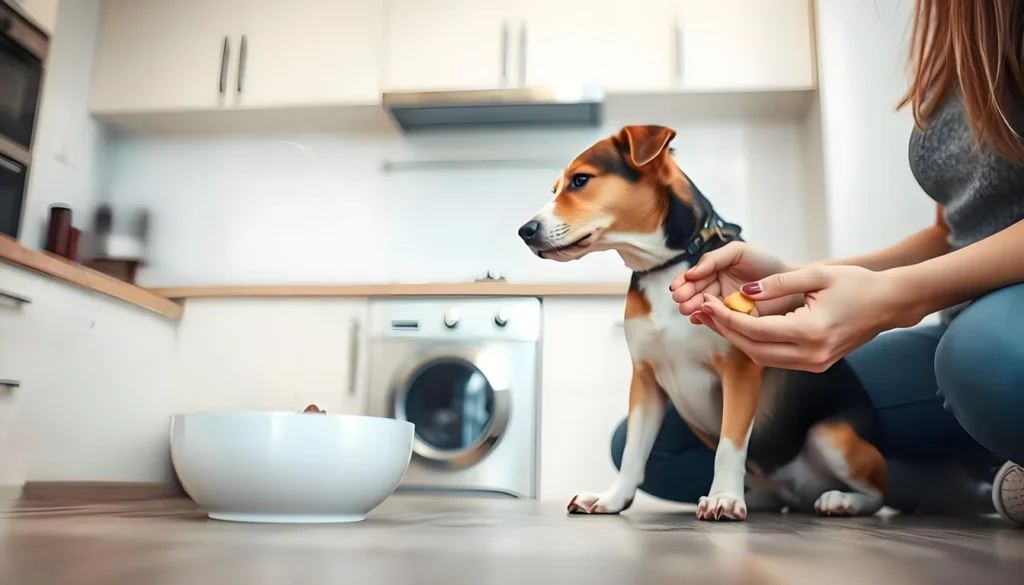
Physical management: crates, gates, separate feeding areas
I use crates, baby gates, closed doors, or separate rooms to feed dogs apart from people and other pets. Low-traffic rooms help the dog relax and feel less pressured.
I pick up empty bowls right away. I never remove a bowl while a dog is still eating. When needed, I tether a dog during training sessions to prevent lunging. These physical management dog food aggression choices stop incidents while training progresses.
Household rules to reduce risk (children, guests, other pets)
I teach children never to approach a dog while it eats, rests, or holds a valued item. Only adults handle behavior plans or changes around food.
I ask guests to remove food from the dog's space and to avoid interacting with the dog during meals. No one tests whether the dog is serious by reaching for the bowl. Clear household rules help prevent food-related confrontations.
Feeding schedule and environment adjustments to lower guarding drive
I feed at set times rather than leaving food out all day. Predictable feeding routines to reduce guarding lower anxiety linked to unpredictability. Avoiding abrupt diet changes stops novel foods from becoming unusually valuable.
For fast eaters, I use slow-feeders so the dog chews more and I get training moments between bites. These feeding routines to reduce guarding pair well with management steps.
I view short-term measures as a safety-first mindset. For some households, management alone keeps everyone safe. If you want to reduce guarding over time, combine these tactics with guided training and professional support to prevent food aggression in dogs.
Desensitization and counterconditioning training exercises
I teach owners simple, safe steps for desensitization. It starts with explaining the science: gradual exposure at low intensity reduces fear. I pair this with treats to teach the dog something positive instead of feeling threatened. My goal is steady calm behavior, not rushed progress.
Principles
Desensitization means exposing the dog to a stimulus slowly. This way, no warning signals appear. Counterconditioning dog food aggression changes the dog’s emotional response by adding a better outcome—usually high-value food when a person approaches. I stress safety: stop if the dog shows tension and get help from a qualified behaviorist when in doubt.
Stepwise “All Good Things” progression
I use the All Good Things game as a repeatable framework. Part 1 starts with me walking by at a distance that causes no reaction. I toss a high-value treat toward the bowl while saying a cue such as “bonus,” then keep walking. I repeat until the dog eats calmly without looking up. Gradually I shorten the distance so treats land closer, then into the bowl.
If a dog already shows strong guarding, I add a barrier like a baby gate or crate. I use the verbal cue before tossing treats until the dog relaxes. I avoid forcing contact with the bowl. I switch to kibble or low-value items first when a dog gulps quickly, then generalize to favorite foods once calm patterns form.
Pacing and measuring relaxed behavior
I advance stages only after consistent relaxed meals. My common benchmark is ten calm, normal-paced meals in a row at one stage before moving closer. I watch for relaxed posture, steady breathing, normal eating pace, and willingness to resume the bowl if distracted by a tossed treat. If the dog leaves the bowl for the treat, I wait and let the dog return on its own timeline.
Practical cautions guide my work. I avoid relying on hand-feeding or intrusive handling unless a certified trainer supervises. For dogs that gulp, I pair exercises with slow-feeders or scatter feeding to reduce rush. These steps explain how to manage food aggression in dogs while keeping everyone safe and building trust.
Advanced training stages and real-world generalization
I have a seven-stage plan for advanced training food aggression. It starts with safe distance work and ends with gentle bowl handling. This builds trust and reduces tension step by step.
I begin with toss-and-treat exercises at a distance. Then, I step closer while tossing. Next, I stand beside the bowl and drop treats before walking away. These early steps provide positive outcomes without pressure.
At the mid-stages, I hand-treat near the bowl and encourage the dog to glance away briefly. I then touch the bowl while offering treats. After that, I lift the bowl slightly, add a treat, and return it. This touch-and-lift work is key for generalizing food guarding in dogs.
Once a dog is comfortable with kibble, I start retraining with different foods. I repeat the whole progression using canned food, cooked chicken, or other high-value items. Dogs often react differently to tastier items, so retraining with different foods prevents setbacks and ensures reliable calm behavior.
Practice in varied locations and with common distractions. I simulate guests, doorbells, and background noise so the dog learns to stay relaxed in real life. Using slow-feeders and scatter feeding creates extra chances to deliver treats during meals.
Family buy-in matters. I require that every adult follow the same steps and never skip stages. Consistency from partners, grandparents, and regular visitors is a cornerstone of my family participation food aggression program.
For children and occasional guests, I recommend management. Separate feeding or supervised visits only after adults have proven consistent results. I rehearse simple household rules and short scripts so visitors know how to behave around the dog.
If progress stalls or stress appears, I pause and consult a qualified behavior professional. Serious cases benefit from supervised sessions to avoid setbacks and to keep everyone safe while working toward generalization food guarding in dogs and lasting calm through advanced training food aggression.
What not to do: common myths and harmful practices
I want to clear up common myths about food aggression in dogs. I also want to point out harmful practices that owners sometimes follow. These can make a tense situation worse, lead to bites, and damage trust between you and your pet.
I urge you to avoid punishment for food guarding. Punitive or dominance-based tactics increase fear and can escalate defensive behavior. I have seen dogs that became more guarded after an owner tried intimidation or physical corrections.
I never recommend testing or startling a dog to “prove” who’s boss. Reaching suddenly for a bowl or clapping hands to startle a dog can trigger a bite. Startling teaches the animal to expect unpredictable, threatening human actions.
Repeated bowl-snatching or intrusive handling often backfires. When people grab food away, dogs learn that people cause their resources to vanish. That pattern can strengthen guarding and raise anxiety around meals.
I focus on safer alternatives. Desensitization and counterconditioning change the dog’s emotional response to people near food. Management steps, like separate feeding spaces, reduce risk while training progresses.
When aggression shows signs beyond mild guarding, I recommend professional help. Trainers with credentials such as CAAB, Dip ACVB, or a certified CPDT know how to assess the two types of aggression in dogs. They create plans that protect family members and the dog.
Below is a compact comparison to help spot risky methods and better options.
| Problematic action | Why it harms | Safer alternative |
|---|---|---|
| Punishment or dominance-based corrections | Increases fear, damages trust, can escalate aggression | Use positive counterconditioning and clear management |
| Startling or “testing” reactions | May trigger defensive bites and conditions fear of people | Approach slowly, pair approach with treats, build tolerance |
| Frequent bowl-snatching or intrusive handling | Reinforces idea that people take food away; raises vigilance | Teach voluntary food exchanges and trade games |
| Avoiding professional help after bites | Unsafe to attempt advanced protocols alone; risk of injury | Consult CAAB, Dip ACVB, or experienced CPDT for a plan |
Conclusion
Preventing food aggression in dogs begins with recognizing early signs. A stiff posture, low growl, or rapid gulping are warning signs. Catching these early can prevent more serious behavior like lunging or biting.
For immediate safety, use separate feeding areas, barriers, and set meal times. These steps help while you work on changing your dog's behavior. Use techniques like staged treat-tossing to help your dog feel calm when people are near their food.
Take small steps and watch for signs of calmness. Practice with different foods and in different places. This helps your dog learn in real-life situations. Remember, punishment or trying to be the boss can make things worse.
If you're unsure or feel it's too risky, get help from a certified behavior expert. They can guide you safely through the process.
My advice is to start with careful management and keep a record of any aggression signs. Make sure your vet checks for any health issues. Then, use gradual, positive steps to help your dog. If needed, seek professional help for a lasting solution.

